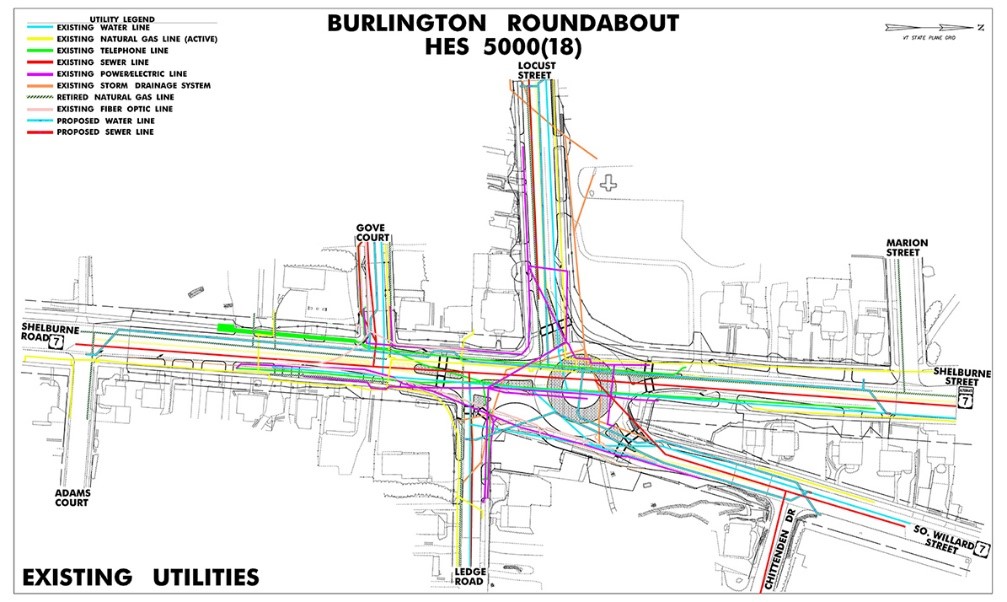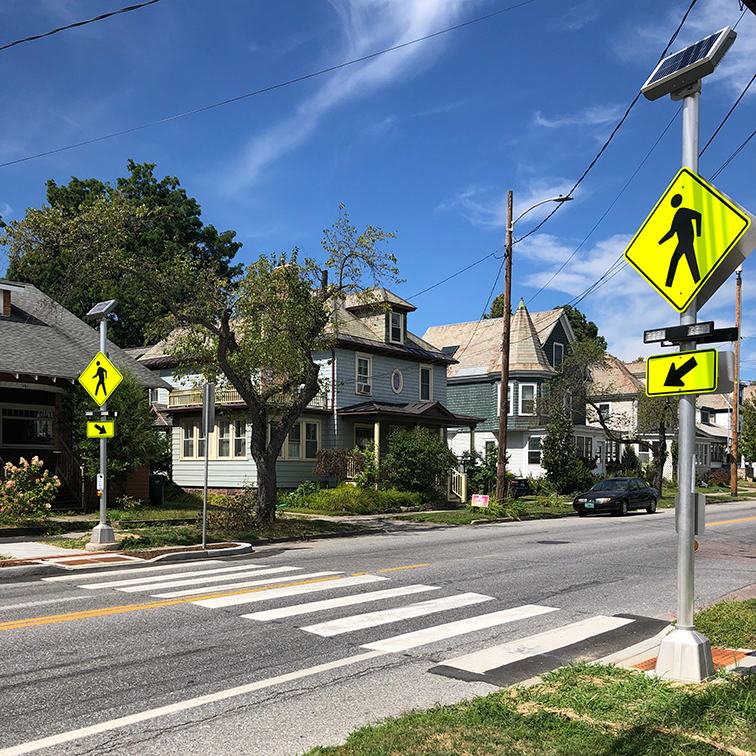
Please review the list of frequently asked questions. If you have a question that is not addressed in the FAQs, please contact the project team.
How long did the construction last?
Construction began in the late summer 2021 and continued through July 2023.
Who was the contractor?
S.D. Ireland Brothers, Corp. of Williston, VT.
Why was this project necessary?
The purpose of this project was to improve the intersection of Shelburne Street (US Route 7), South Willard Street, Locust Street and Ledge Road in the South End of Burlington, Vermont, for all users.
The need for this project was evident by the number of vehicular collisions, a number of them resulting in severe injury, over the last quarter century. Additional factors included excessive vehicular speeds, traffic queuing, overall high traffic volumes during peak commuting hours, and the difficulty in crossing the roadway by pedestrians and bicyclists.
A 2002 Shelburne Street Rotary Report identified that during peak hours, cars experience difficulty entering the roadway from both local side street (Locust Street and Ledge Road) as well as the more significant city streets (South Willard and South Union). The Report identified the need for the roadway redesign evidenced by:
- Frequent traffic queuing, especially at South Willard Street causing delays.
- Frequent interruptions in traffic flow.
- Traffic that travels at inappropriately high speeds.
- Poor access for pedestrians and bicyclists along the roadways and intersection.
- Poor visual quality of the landscape and improvements at the intersection.
Since the completion of the 2002 report, VTrans has identified the rotary as a high crash location. This required the purpose and need statement to elevate the importance of addressing the specific deficiencies that caused this location to be designated a high crash location.
Why was a roundabout determined to be the best option?
The Roundabout design was selected because it is the best-engineered solution to manage continuous decreased vehicular speeds, offers up to a 35% crash reduction rate, and a 72% reduction in crash-related injuries provides pedestrians and bicyclists the shortest street crossings with the highest rate of visibility, can accommodate large trucks as necessary, and provides the opportunity for future expansion if needed. The new roundabout is also more environmentally friendly than a traditional signalized intersection by encouraging slower moving, and constant flowing traffic while adding modern stormwater treatment facilities. Modern roundabouts can reduce vehicle delay by up to 75% over signalized intersections, keeping traffic moving freely and safely. Finally, it provides the City of Burlington with a gateway that is aesthetically pleasing and attractive for all users.
Where did construction happen?
The Shelburne Street Roundabout project was located at the intersection of US Route 7 (Shelburne Street, South Willard Street), ALT US Route 7 (Shelburne Street to South Union and St. Paul Streets), Locust Street and Ledge Road in the City of Burlington, VT. The project limits extended from Shelburne Street at Adams Court to South Willard Street at Chittenden Drive and on Shelburne Street along ALT US Route 7 to Marion Street. Work was also being conducted on the following side streets: Gove Court, Locust Street and Ledge Road.

Where were the detour routes located and when did the detours begin and end?
Please review the traffic impacts for each construction phase outlined on the Construction Phases page.
How were neighboring streets affected by construction?
The project did not plan to restrict traffic from seeking alternate routes to avoid the work zone. The project team did not have the ability to keep motorists familiar with the local roads from using them. However, the project team did not be encourage people to seek neighborhood streets as an alternate route to their intended destination. Local law enforcement worked to ensure that posted speed limits were monitored and enforced.
With advance notice, some local roads adjacent to the project were intermittently restricted to one-way traffic either in or out of the intersection, depending on the construction phase.
Neighboring sidewalks were at times be affected as well. In each case, advance notice was provided.
Was street parking affected?
The contractor made every effort to keep as much open street parking as possible, particularly at night when many residents require access. Arrangements were made by the City of Burlington for an alternate parking location should the need arise. Some on-street parking was affected day to day over the course of construction, but efforts were made to minimize the impact. When construction concluded, all on-street parking was restored.
Did residents along the construction route have access to their driveways?
Access to residences and businesses was maintained throughout the project. If the contractor anticipated accesses to be blocked, the contractor visited residences and leave notices. All pre-planned access closures were as short as possible.
Was there night construction?
Project construction was generally be restricted to daylight hours. Nighttime work was not allowed unless a specific activity is considered an emergency (i.e., utility service disruption, etc.) or if an activity severely impacted daytime traffic.
Did construction take place during the winter?
Large-scale winter work was not anticipated on this project, and any winter activities that did occur were minimal. Note that utility relocations might have occurred during the winter. Winter shut down for roadway work is from December 15 through April 15.
How early in the day did construction start?
The contractor and construction team are cognizant that this was a residential neighborhood and sought to minimize disturbances before 7 AM. While construction is permitted to begin as early as 6 AM, in most cases construction activity began 7 AM or later.
Was there weekend construction?
Construction was generally restricted to weekdays. Saturday work was permitted depending on the construction activity and circumstances, such as emergencies or work that was not able to be completed before nightfall on Friday evenings. Sunday work was prohibited.
How did bicyclists and pedestrians navigate the roundabout?
The roundabout and the streets approaching it have sidewalks and shared-use paths dedicated to pedestrian and bicycle usage, to safely navigate the intersection. For pedestrians, the new roundabout provides shorter, more visible crosswalks. Additionally, signal beacons are in place which pedestrians can activate, indicating to cars entering and exiting the roundabout that pedestrians are at the crosswalk, with the right-of-way to cross.

A shared-use path is available for pedestrians and bicyclists. Bicyclists have the option to navigate the roundabout like a motor vehicle or use the shared-use path if they do not feel comfortable riding in the roundabout. For more information on navigating the roundabout for pedestrians and bicyclists, please view this project video.
How is vehicle speed be controlled?
Speed limit signs are posted, and enforcement is the responsibility of local law enforcement. Splitter islands are installed at all entry points of the roundabout. These islands help reduce the speed of vehicles entering the roundabout. By design, the roundabout slows surrounding traffic, reduces the risk of accidents, and provides for a safer environment for vehicles, bicyclists, and pedestrians.
What was the procedure for rock removal?
Due to the presence of ledge and bedrock, some blasting and hammering occurred. Since the project was near businesses and residences, the contractor reached out to all buildings within 500 feet of the project limits to ensure their safety.
How was dust be mitigated?
Dust from construction activity is unavoidable. The contractor was required to have materials such as water and calcium chloride available on site at all times to keep dust proliferation to a minimum.
Did construction impact access to utilities?
Yes. There are 37,000 ft (~7 miles) of existing utility infrastructure in the project area. Construction inevitably caused some interruptions to all utilities, including gas, water, sewer, storm, electric, telephone, telecom, fiber and cable TV. Existing utility services remained active throughout the project, but there were minor shut-offs with advanced warning. In the case of planned outages, at least 48 to 72-hours advance notice was provided to those impacts. The project coordinated with the City of Burlington and public utility services to ensure advance notice was provided, and interruptions were kept as short as possible.
For private utilities, the utility companies were responsible for notifying customers.
What happened to existing trees in the project area?
Any trees that needed to be removed were replaced with new, young trees in keeping with the City of Burlington’s arbor plans. Additionally, the central island created an opportunity for aesthetic landscaping treatments and serve as a city gateway.
